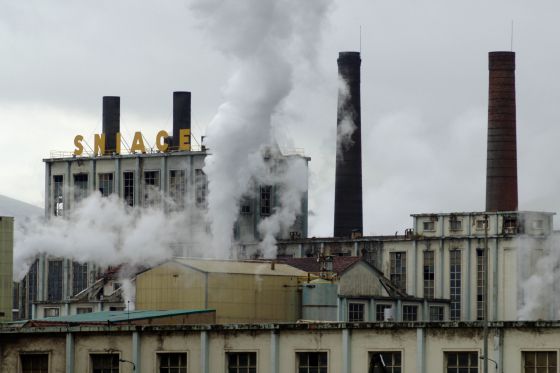SNIACE (Sociedad Nacional de Industrias Aplicaciones Celulosa Española) is a company located in Torrelavega (Cantabria) which was founded in Madrid in 1939 as a public limited company for an indefinite period of time and settled in Cantabria in 1941. This industrial chemical group is in charge of producing cellulose, fibrana, lignosulfonates, electric energy and until the end of 2005, polyamide. From the beginning it had a great development, a diversification of its products and a series of solid relations with the companies of its environment. In addition, it provided work for more than 3,500 people in an area where unemployment was abundant. However, today it is in trouble and has many obsolete facilities.

Photo 1. View of the SNIACE factory, Torrelavega (Source: www.cantabriaindustrial.com)
It was probably the biggest consumer of water in Spain, when the factory was built, it obtained an authorization to capture from Besaya. However, when that water returned to the river it was loaded with organic matter from the treatment of cellulose which made life in it unviable. The immediate effect can be seen in the fishing village of Suances, which is the one that directly suffers the pollution problems due to the fact that its fishing is decreasing more and more. However, this is not the only problem caused by this factory, the problems of pollution in the rivers is coupled with poor air quality, another consequence is therefore, the impact it has on the health of citizens who claim to be suffering respiratory problems by the emissions of acid gases, bisulfites and concentrations of bleach emitted by the company in addition to the noise it produces.
Over the years it seems that awareness of the environmental impact that the factory was causing has grown and several controversies have arisen.
According to an article in the newspaper EL País of 17 November 2016, the factory in that year pollutes more than a city of 500,000 inhabitants that discharged its untreated sewage into the river. The plant discharges 1,000 liters per second of waste and heavy metals into the river Besaya, despite the fact that in June the Ministry of the Environment withdrew the authorization for dumping for its repeated breaches.
The same article refers to one of the main consequences of the factory's emissions. According to data from the Water Commissariat of the Northern Hydrographic Confederation, dependent on the Ministry of the Environment, both the bad smell and the murky color of the river waters are due to the excessive concentration of chloroform in them, if the maximum concentration of chloroform admissible is 12 micrograms per liter, the company's discharge reaches 420 micrograms. In the river, the concentration is 220, 18 times more than what is allowed.
Since 2002, the company has had a provisional discharge permit that forced it to progressively reduce its pollution. However, it has been seen that it has not complied with its obligations. In recent years, the confederation has opened various sanctioning proceedings worth 180,000 euros" and "has another in process of more than 100,000, according to sources in the confederation.
In April 2005, the Confederation, tired of measuring unbearable pollution, began the process of withdrawing the discharge permit after having been warned of its non-compliance by the European Commission. The company appealed and on 31 October the High Court of Justice of Asturias agreed with the ministry and recalled that the general interest of the environment is superior to the particular interest of the mercantile. The president of the Hydrographic Confederation of the North, dependent on the Environment, Jorge Martínez affirms that the 650 jobs generated by the company have weighed a lot and have served the administrations to have excessive wide sleeves with the company.
In a recent article in the newspaper El Pais of January 8, 2019 indicates that the Provincial Court of Cantabria has given the reason to Ecologistas en Acción Cantabria and the Public Prosecutor and has expanded the investigation for the discharges that occurred.

Photo 2. SNIACE factory, Torrelavega (Source: www.elpais.com)
Therefore, it has become clear that this is a very serious problem that has persisted over time for many years and that despite its seriousness and the measures that have been taken, no conclusive measure has been taken to put an end to this problem. Therefore, it is clear that in this case the industrial project and guaranteeing the environmental conditions are incompatible and that the only efficient measure in the face of this problem would be to close the factory definitively and thus prevent it from continuing to pollute with all that this entails.
Álvaro Baeza Cabrero
